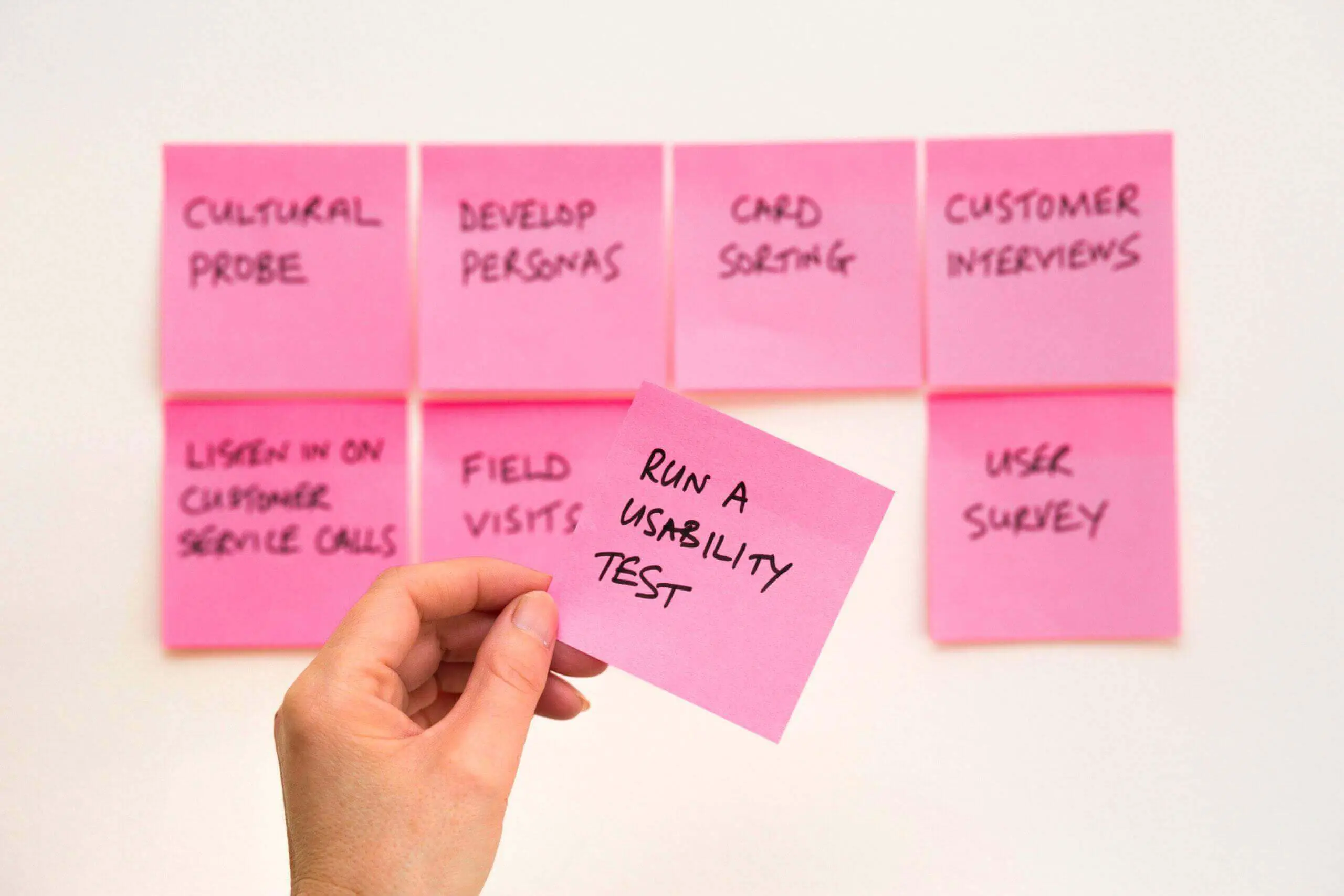

Customers crave positive experiences when using a product. Those positive experiences typically result in higher levels of customer satisfaction. That influences whether customers use your products in the future and recommend those products to other people.
So user experience can have an enormous impact on business success. What happens when customers have phenomenal user experiences? Repeat and referral business, which can lead to more revenue.
Learn how to improve user experiences below.
Short definition: User experience is how someone behaves when interacting with a product. It can include how well a person navigates a product's features, how easy they find a product to use, and how much value they get from a product.
User experience, end-user experience, or UX refers to the behaviours a consumer displays when experiencing a product. It's about how a customer feels when they use a product. It's about the value they get from that product. It's about how easy it is for them to use.
UX isn't just about giving customers the product features they want. It involves creating products that:
It means designing products that help end-users achieve their goals.
Think about the last product you bought. Perhaps it was something online. Now think about how that product made you feel. Did it meet your expectations? Did it solve a problem you had? Ultimately, was it a good product? The answers to those questions reveal whether that product provided a good user experience.
UX in a digital sense refers to how people interact and engage with digital products like websites and apps. Like any other product, UX designers need to create digital assets that provide excellent user experiences. So digital UX design might involve personalising a digital product, making it affordable, or creating something with a real purpose.
User interface (UI) is the point where users interact with a digital product like a website or software. It is an important component of user experience because it tells designers how people engage with their products.
You can test the user experience with surveys, interviews, heatmaps, and other methods. (More on this later.)
It's the process UX designers use to make changes to products that benefit users. That might involve making a website more accessible or an app more user-friendly.
UX designers research to learn more about the people who use a product. That research might include interviewing customers or hosting workshops.
UX strategy refers to the techniques designers use to improve UX design. Having an effective UX strategy can increase the quality of products and help designers align their business goals with user needs.
UX goals depend on the organisation that wants to improve UX design. Some common goals include increasing website session durations or page views.
UX is important because it addresses customer needs and provides better experiences for people using a product. Good UX can lead to brand loyalty, increased revenue, and product referrals. It can also provide customers with more value.
UX is constantly evolving because customers have ever-changing requirements and values. That's why designers have to continuously monitor UX design and adapt quickly to customer demands and preferences.
Design systems keep user experience consistent which drives the success of a digital product. They consist of a collection of repeatable components and set of standards to guide the use of those components which, when assembled together, can build any number of applications.

UX designers regularly crunch numbers and plot graphs to quantify the user experience. They also reach out to customers to learn what people really want from a particular product. Here are some of the ways to measure UX:
Complicated computer algorithms can reveal product experience insights from customers. But the simple survey can provide UX designers with just as much wisdom about the user experience. Surveys collect feedback from customers so designers can learn about concepts such as:
This feedback might take the form of simple questions about a product. Take a website, for example:
By asking customers these questions, UX designers can identify user pain points. They can also discover whether a soon-to-be-launched product will be a success or not.
There's a problem, though. Customers won't always provide honest answers on surveys and can give generic feedback without thinking about their responses.
Interviews are similar to surveys but provide more context about UX. For example, you can assemble a focus group of customers that match your demographic and ask them questions about your product. Unlike surveys, you can ask customers to elaborate on their answers and use follow-up questions. But, like surveys, you might not always get honest feedback from focus groups, especially if participants don't want to offend you.
Heatmaps are particularly useful for digital products like websites and apps. They generate real-time intelligence about how customers interact with these products. A heat map is essentially a 2D representation of data that lets you visualise UX data in one place. It uses different colours to illustrate specific data values.
Say you were testing a website and wanted to discover how customers engage with your pages. A heatmap can tell you what pages — and what parts of those pages — resonate with users. For example, you can learn how long users spend on particular pages or whether they click on call-to-action buttons.
The problem with heatmaps is that not all designers know how to interpret the data on them. Heatmaps don't always work with smaller data sets, either.
A/B testing (or split testing) measures UX by presenting two variants of a digital asset like a webpage to users. By comparing both versions of that webpage, you can determine the most effective one. For example, you might place a navigation menu on the top of one webpage and a menu at the bottom of the other webpage. Then you can see which menu placement engages users more.
A/B tests prove valuable for measuring UX. But they can be difficult to set up and take up a lot of resources.
None of the techniques above is perfect. But the best UX designers can use these methods to create real change for organisations that want to improve user experience. They overcome the limitations of each tool and uncover unparalleled insights about UX that result in better products.
Data errors can occur if some respondents answer a particular question on a survey and others don't respond, creating a bias. Then there's the problem of respondents not understanding specific questions on a survey, which can also skew results. That's why UX designers should dig deeper and use surveys in a way that uncovers meaningful insights.
Designers can only create real change in UX design if surveys lack bias, have a purpose, and encourage participants to give honest opinions. So the most effective surveys include a mix of closed-ended and open-ended questions, have relevant questions, and tell respondents about the purpose of the survey.
Interviews share many of the same problems as surveys. An interviewer might ask closed-ended questions that result in answers with little context, for example. Simple "yes" and "no" answers don't disclose what a customer thinks about a product's nuances. These problems can be worse if interviews take place online or happen quickly.
One way UX designers overcome these challenges is by getting to know different customer types as they interact with a product. Distinction recently ran 25 face-to-face workshops across the United States, travelling around the country to learn how customers engaged with its client Recorded Books' website. They also met customers in the UK and ran online workshops in Australia. Soon, Distinction discovered what customers wanted from Recorded Books' website: A site that was easy-to-use, robust, and smooth. It would have been difficult to garner these insights with conventional interviews alone. By meeting and spending time with customers in person, Distinction optimised the Recorded Books site. That eventually led to a 99 per cent increase in session durations and a 63 per cent increase in page views per session. Recorded Books now has the No.1 website in its market.
Sometimes heatmaps can be confusing. For example, you might discover a website user spends a long period on a particular page, but you don't know why. Try combining heatmaps with other methods for measuring UX. You can generate deeper insights into customer behaviour and receive context for heatmap data.
One of the best methods for measuring customer behaviour is workshops, which allow designers to meet with customers face-to-face. They can also dig deeper into user requirements.
Distinction carried out a series of workshops on behalf of healthcare-at-home organisation Bluebird Care. The organisation wanted to improve the customer experience on its website. By meeting with carers, franchisees, and people arranging care for loved ones, Distinction learnt what these users wanted from the Bluebird Care website. After improving the customer experience, Bluebird Care's website generated an increase of 68 per cent in users.
A/B testing can be labour-intensive and sometimes take several months to produce accurate results. That's because you want to compare product variables over time. One way to drive change in UX design is to start the A/B testing process as early as possible. That gives designers enough time to identify patterns and trends in data that lead to better product design.
While A/B testing takes place, designers can outline a roadmap for UX transformation. A roadmap details the changes an organisation needs to make to a product. It also lists timelines for which those changes should happen. That provides a framework for success and summarises the skills and resources required to reach UX goals. Distinction created a roadmap for continual digital innovation for the Building Societies Association. This roadmap, among other techniques, helped the organisation generate a 9.5 per cent increase in session duration. The Building Societies Association also experienced a 7 per cent increase in registered online use.
You can always test your new user experience by using the same tools that identified the problems with your UX. For example, you can carry out surveys, interviews, workshops, or other methods to learn what customers think about your new UX. That lets you continue to improve and make changes.
UX design is a continuous process. You start by identifying the problems with your existing UX setup with the right tools and techniques. Then you make changes to UX. Finally, you measure the success of those changes to learn whether you made the right choices. Then you repeat this process again and again. User requirements can change over time, so you'll want to stay ahead of the curve and continuously tweak the user experience to satisfy customers.
UX is more difficult now than it's ever been. That's because customers expect more when they use a product and have an ever-growing list of requirements. Creating a generic product that offers customers little value will no longer cut it. Customers want products that provide exceptional user experiences. They want products to satisfy their specific needs. They want products that add value to their lives. So designers go above and beyond to meet these demands by continuously measuring UX design.
To improve the user experience, you need to measure it. Techniques like heatmaps, surveys, A/B testing, and interviews can prove lucrative when discovering customer expectations and requirements for a product. But you need to optimise these methods to make any real change to UX design. By overcoming the challenges in measuring UX and digging a little deeper into customer feedback, you can consistently deliver positive experiences that inspire digital product loyalty and advocacy.
If you’re looking for a UX partner to help enhance your product’s digital experience then get in touch to have a chat with our team.